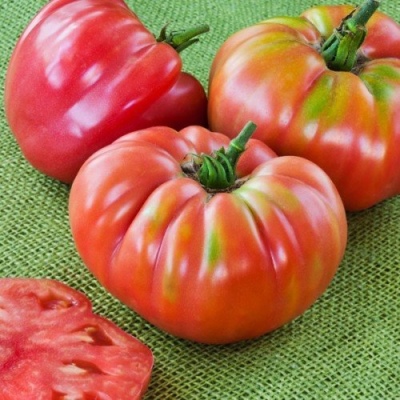
- Authors: Siberian selection
- Category: grade
- Growth type: semi-determinant
- Ripening period: mid-early
- Ripening time, days: 105-110
- Growing conditions: for film greenhouses, for closed ground, for greenhouses
- Bush size: tall
- Bush height, cm: up to 200
- Ripe fruit color: raspberry
- Fruit shape: flat-round
The Siberian tomato variety Zimarevsky giant is distinguished by large clusters, it stably maintains its yield, regardless of weather changes. This variety is in great demand among gardeners.
Description of the variety
Tomato Zimarevsky giant has a height of about two meters. Depending on the planting period, the bushes form up to 5 brushes with large vegetables. This variety can be grown both in the open field and in greenhouse structures.
It should be remembered that this variety has a rather short shelf life, poor transportability. The variety boasts high resistance to low temperatures and can be grown in areas with a short summer season.
The main qualities of the fruit
Ripe fruits of this type have a rich and bright raspberry color. All of them are large in size, the weight of one tomato can vary from 300 to 400 grams.
The ripened vegetables are flat-round. One cluster contains 5-6 fruits. Their skin is smooth.
Taste characteristics
This tomato variety boasts excellent taste. Ripe tomatoes can be consumed naturally. And they are also often used in the preparation of juices, sauces, salads.
Ripening and fruiting
The variety Zimarevsky giant belongs to the mid-early species. Ripening dates are approximately 105-110 days after planting in open soil. The harvest dates are from July to August.
Yield
This type allows you to get a large harvest. It is quite possible to collect about 10-15 kilograms of fresh fruits from 1 square meter of territory.
The timing of planting seedlings and planting in the ground
Sowing seedlings is recommended in mid-March. Planting in open soil is carried out in mid-May, and it is better to do this under a special film cover. If you transplant in June, then such protection will not be needed.

Growing tomato seedlings is an extremely important process, because it largely depends on whether the gardener can harvest at all. All aspects must be taken into account, from seedbed preparation to planting in the ground.
Landing scheme
Sowing seedlings is performed in different containers. You can purchase special containers for this. It will be necessary to prepare the earth in advance, it is mixed with nutritious dressings so that in the end a homogeneous mass is obtained. The resulting mixture will need to be moistened, it should remain slightly moist. For seed germination, the air temperature should be approximately 23-25 degrees Celsius.
When the first shoots are formed, it is best to place all containers with young vegetation under special phytolamps. When three leaves are formed, you can transplant to a permanent place.
When planted in open ground, there should be 3 plants per 1 square meter of territory.All planting holes are pre-added with special fertilizing, you can use ready-made complex fertilizers that contain all the main important substances.
Immediately after planting, the ground around young plants must be thoroughly moistened. Plants will also need to be tied to supports.

Growing and care
This variety will need regular watering and top dressing. It is important to use mineral complex fertilizers. To accelerate the growth of bushes, the germination process of seed, you can also use special growth stimulants.
These tomatoes need careful preventive treatments. You can use a variety of homemade folk remedies. And also ready-made preparations are often purchased for this. Most often, treatments are carried out by spraying plants.
Particular attention should be paid to the formation of the bush. This procedure also provides a high level of yield. During this event, all weak and damaged shoots should be removed, leaving only strong and healthy parts. It should be noted that the variety Zimarevsky giant has a fairly high resistance to adverse weather conditions.




A plant needs different micronutrients at each stage of growth. All fertilizers can be divided into two groups: mineral and organic. Folk remedies are often used: iodine, yeast, bird droppings, eggshells.
It is important to observe the rate and period of feeding. This also applies to folk remedies and organic fertilizers.
Disease and pest resistance
This culture has an average immunity to disease. Often she suffers from fusarium, late blight. To avoid their appearance, it is recommended to carry out preventive fungicide treatments, and they are best performed in the spring season. Sometimes a variety of insecticides are used for this.
Various harmful insects can also appear on the bushes, including whiteflies, spider mites, and aphids. It is necessary to periodically carefully inspect all plants for the presence of such organisms. If they are found, chemical treatment should be carried out immediately in order to accurately destroy all insects.



























































































